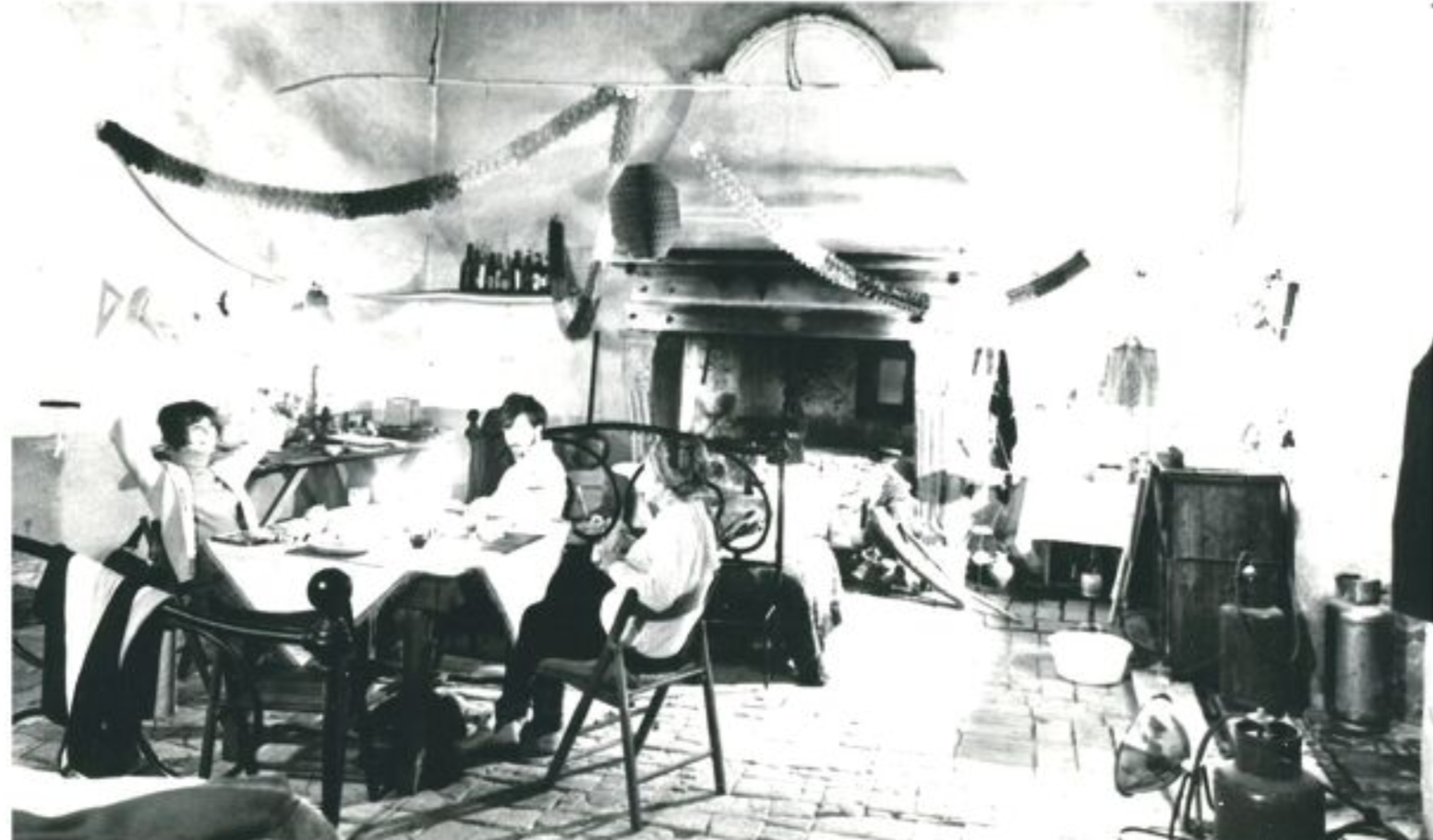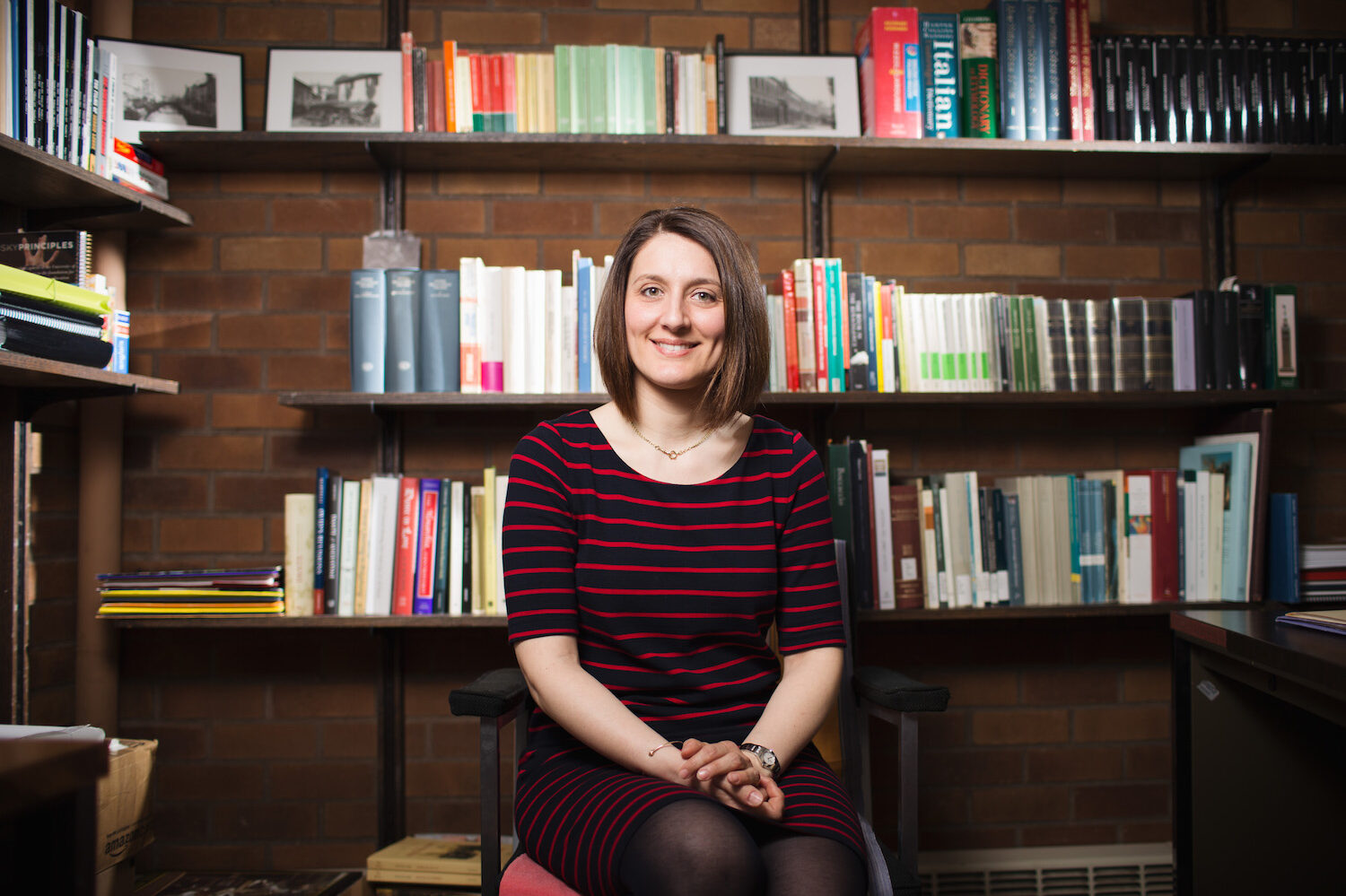Astra Zarina, who studied architecture at the University of Washington in the early 1950s and later became a UW professor, began traveling to the picturesque hill town of Civita di Bagnoregio in the 1960s.
This historic gem, perched high atop a slim pinnacle of land, seemed to be frozen in time. Devastated by an earthquake in 1695, bombed during World War II, home to just a handful of full-time residents, the 2,500 year-old town of Civita was built on soft clay that crumbled “like fresh ricotta,” according to the New York Times, putting its hilltop perch in constant jeopardy.
Nonetheless, Zarina was captivated by the village, its buildings and its rich history. On one of her early visits, she was caught in a fierce rainstorm and was invited to wait out the storm in a local home. As she admired the large fireplace, the family offered to sell her the one-room house. She bought it on the spot and spent the next two years restoring her “room” as well as undertaking several other restoration projects in Civita.
In 1976, she established a much-beloved UW study-abroad program in Civita called Italian Hilltowns, a complement to the UW’s successful Architecture in Rome program which she had established six years earlier. In 1981, Zarina and her husband Tony Costa Heywood co-founded the Civita Institute in Seattle, a nonprofit organization that promotes excellence in design through educational programs and cultural exchanges between the two countries.
Over the decades, the couple worked hand-in-hand with Civita residents, UW students and others to protect and preserve the town’s architecture, history and culture. They retired to Civita full-time in 2001, and Zarina taught her last class there in 2003. She died on August 31, 2008, at the age of 79.
About 15 years ago, Palazzo Alemanni, a city-owned museum building in Civita, dedicated a room to Zarina, choosing artifacts to represent her impact on the city. But the town wanted a more permanent reminder of her influence, so members of the Civita Institute were asked to help design an exhibit.
Last summer, “Astra Zarina in Civita” opened. The exhibit was created by a trio of Seattle architects and artists from the Civita Institute, and staged in collaboration with the city of Bagnoregio and the Geological and Landslides Museum.
Installed in one of the rooms of the Renaissance-era Palazzo Alemanni – the same room where years earlier Zarina had taught her students – the exhibit focuses on three areas of Zarina’s story: her life, her teaching and her legacy. The exhibit’s main installation is made up of six video projectors displaying images, video and text along the room’s walls.
“The projectors are operated by remote control,” said Seattle artist and exhibit designer Iole Alessandrini. “It’s not a static installation, but a flexible system. That means if the museum needs the space for something else, such as a special event or lecture, they can shut off the projectors and set up the room for another purpose.”
Working with Alessandrini on the exhibit were Civita Institute board member Clark Pickett, who researched photographs and created the video content for the display, and Nancy Josephson, the Institute’s current president, who served as project manager. Additional support was provided by Jordan Hughes, Sharon Mentyka and Cinzia Rocchi.
When planning the exhibit, the team wanted to portray Zarina’s influence and legacy as accurately and as engagingly as possible. But it was not an easy task. “We wanted to get the concept just right,” said Josephson, “but after several years, we felt we were not really hitting the mark. A few years ago, we went back to the drawing board with new committee members. Within five months, a new concept and design emerged.” A budget of $20,000, raised by members, was earmarked for the display.
Born in Italy, Alessandrini met Zarina in Rome in the early 1990s. “Zarina said to me, you should come to Seattle and study at the University of Washington,” she recalled. “At the time, I didn’t even know where Seattle was. But I worked to make it happen. When I arrive, she and Tony were like family to me. My mother died when I was 19 and my father, six years later. They filled a big gap for me.”
Since moving to Seattle in 1994, Alessandrini has established a reputation for innovative public art installations that manipulate light, digital media and space. She was recently chosen to create a laser-lit installation at KeyArena, home of Seattle’s new hockey team, which will open in 2021. She brought these talents to bear on “Astra Zarina in Civita.”
Alessandrini spent three months designing the exhibit and another month in Civita installing it. “The location is great,” said Alessandrini. “You walk up some steps in the Palazzo Alemanni, you see the projected images and it makes you pause. Her spirit is felt through these images and words.”
“Astra Zarina in Civita” opened August 25, 2019, the 90th anniversary of Zarina’s birth. Her husband, who lives full-time in Civita, was present as Luca Profili, mayor of Bagnoregio and Civita di Bagnoregio, cut the ribbon during the opening festivities.
The Civita Institute hopes the exhibit will continue to strengthen the ties established between Astra Zarina and the people of Civita. “People just loved her in Civita,” said Alessandrini. “Some of the adults today knew her when they children. She saw the potential in them as individuals and in their town, and they are grateful for all she did.”
Astra Zarina, che ha studiato architettura all’Università di Washington all’inizio degli anni Cinquanta e successivamente è diventata professore alla UW, ha iniziato a viaggiare nella pittoresca cittadina collinare di Civita di Bagnoregio negli anni Sessanta.
Questo storico gioiello, arroccato in cima a un sottile pinnacolo di terra, sembrava congelato nel tempo. Devastata da un terremoto nel 1695, bombardata durante la Seconda Guerra Mondiale, casa di una manciata di residenti stabili, la città di Civita, vecchia di 2500 anni, è stata costruita su morbida argilla che, secondo il New York Times, si è sbriciolata “come ricotta fresca”, mettendo costantemente a rischio la sua collina.
Tuttavia, Zarina è rimasta affascinata dal villaggio, dai suoi edifici e dalla sua ricca storia. Durante una delle sue prime visite, è stata sorpresa da un violento temporale ed è stata invitata ad aspettare la fine della tempesta in una casa del posto. Mentre ammirava il grande camino, la famiglia ha proposto di venderle un monolocale. Lo comprò su due piedi e passò i due anni successivi a restaurare la sua “stanza” e a intraprendere diversi altri progetti di restauro a Civita.
Nel 1976 ha istituito a Civita un programma di studio all’estero molto amato da UW, chiamato Italian Hilltowns, un complemento al programma di successo della UW Architecture in Rome che aveva istituito sei anni prima. Nel 1981, Zarina e suo marito Tony Costa Heywood hanno co-fondato il Civita Institute di Seattle, un’organizzazione no-profit che promuove l’eccellenza nel design attraverso programmi educativi e scambi culturali tra i due paesi.
Nel corso dei decenni, la coppia ha lavorato fianco a fianco con i residenti di Civita, gli studenti di UW e altri per proteggere e preservare l’architettura, la storia e la cultura della città. Si è poi ritirata definitivamente a Civita nel 2001, dove Zarina vi ha tenuto la sua ultima lezione nel 2003. È morta il 31 agosto 2008, all’età di 79 anni.
Circa 15 anni fa, Palazzo Alemanni, edificio museale di proprietà della città di Civita, ha dedicato una sala a Zarina, scegliendo alcuni manufatti per rappresentare il suo impatto sulla città. Ma la città voleva un ricordo più permanente della sua influenza, così i membri dell’Istituto Civita sono stati invitati a contribuire alla progettazione di una mostra.
La scorsa estate ha aperto “Astra Zarina in Civita”. La mostra è stata realizzata da un trio di architetti e artisti di Seattle del Civita Institute, e messa in scena in collaborazione con la città di Bagnoregio e il Museo Geologico e delle Frane.
Installata in una delle sale del rinascimentale Palazzo Alemanni – la stessa dove anni prima Zarina aveva insegnato ai suoi studenti – la mostra si concentra su tre aree della storia di Zarina: la sua vita, il suo insegnamento e la sua eredità. L’installazione principale della mostra è costituita da sei videoproiettori che mostrano immagini, video e testi lungo le pareti della sala.
“I proiettori sono azionati da un telecomando”, ha detto l’artista e exhibition designer di Seattle Iole Alessandrini. “Non è un’installazione statica, ma un sistema flessibile. Questo significa che se il museo ha bisogno dello spazio per qualcos’altro, come un evento speciale o una conferenza, può spegnere i proiettori e allestire la sala per un altro scopo”.
Con Alessandrini alla mostra hanno collaborato il componente del consiglio di amministrazione del Civita Institute Clark Pickett, che ha svolto ricerche fotografiche e ha realizzato i contenuti video per la mostra, e Nancy Josephson, attuale presidente dell’Istituto, che ha svolto il ruolo di project manager. Un ulteriore supporto è stato fornito da Jordan Hughes, Sharon Mentyka e Cinzia Rocchi.
Nel pianificare la mostra, il team ha voluto rappresentare l’influenza e l’eredità di Zarina nel modo più accurato e coinvolgente possibile. Ma non è stato un compito facile. “Volevamo realizzare il giusto concept”, ha detto Josephson, “ma dopo diversi anni, ci sembrava di non essere all’altezza della situazione. Qualche anno fa, siamo tornati al tavolo da disegno con nuovi membri del comitato. Nel giro di cinque mesi, è emerso un nuovo concept e un nuovo design”. Per l’esposizione è stato stanziato un budget di 20.000 dollari, raccolti dai soci.
Nata in Italia, Alessandrini ha incontrato Zarina a Roma nei primi anni Novanta. “Zarina mi ha detto: “Dovresti venire a Seattle e studiare all’Università di Washington”, ha ricordato. “All’epoca non sapevo nemmeno dove fosse Seattle. Ma ho lavorato perchè ciò succedesse. Quando sono arrivata, lei e Tony sono stati per me come una famiglia. Mia madre è morta quando avevo 19 anni e mio padre, sei anni dopo. Hanno riempito un grande vuoto per me”.
Da quando si è trasferita a Seattle nel 1994, Alessandrini si è affermata grazie a una delle più innovative installazioni d’arte pubblica che manipolano la luce, i media digitali e lo spazio. Recentemente è stata scelta per creare un’installazione illuminata al laser a KeyArena, sede della nuova squadra di hockey di Seattle, che aprirà i battenti nel 2021. Ha portato questi talenti in “Astra Zarina in Civita”.
Alessandrini ha passato tre mesi a progettare la mostra e un altro mese a Civita per installarla. “La location è fantastica”, ha detto Alessandrini. “Si sale qualche gradino di Palazzo Alemanni, si vedono le immagini proiettate e si fa una pausa. Il suo spirito si percepisce attraverso queste immagini e le parole”.
“Astra Zarina in Civita” ha aperto il 25 agosto 2019, nel 90° anniversario della nascita di Zarina. Suo marito, che vive a tempo pieno a Civita, era presente mentre Luca Profili, sindaco di Bagnoregio e Civita di Bagnoregio, ha tagliato il nastro durante la cerimonia di apertura.
L’Istituto Civita si augura che la mostra continui a rafforzare i legami stabiliti tra Astra Zarina e la popolazione di Civita. “A Civita la gente la amava”, ha detto Alessandrini. “Alcuni degli adulti di oggi l’hanno conosciuta da bambini. Lei vedeva il loro potenziale come individui e nella loro città, e le sono grati per tutto quello che ha fatto”.






























